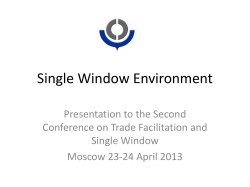
Document 126313
Quantity Measurement Expert Group meeting on International Merchandise Trade Statistics First meeting New York, 3-6 December 2007 Quantity Measurement Introduction by Markie Muryawan International Trade Statistics Section, December 2007 1 Quantity Measurement Importance of quantity • It may provide a more reliable indicator of international movement of goods because it is free of valuation problems • It can be used in checking the reliability of the value data • It is indispensable in the construction of index numbers and for transportation statistics International Trade Statistics Section, December 2007 2 1 Quantity Measurement Recommended Quantity Units • WCO recommended a single standard unit of quantity for each HS six-digit sub-heading – To facilitate the collection, comparison and analysis • Quantity units obtained from countries by UNSD are, where necessary and possible, converted / estimated to WCO Recommended Units • UN Comtrade disseminates data with WCO recommended quantity units and tries to complete data series, where quantities are missing. International Trade Statistics Section, December 2007 3 Quantity Measurement Quantity Unit Conversion used on internal data processing system • There are two kinds: – Mathematical conversion, such as inch to meter – Specific gravity of the commodity involved • Best done at national level • FAO example: 1000 coconuts = 1 metric ton (broad-based conversions at international level) • Reported quantity in units other than WCO recommended is converted using FAO conversion factors during data processing – Countries which use units of quantity other than the WCO recommended units are requested to provide conversion factors. International Trade Statistics Section, December 2007 4 2 Quantity Measurement FAO Conversion Factors used on internal data processing system International Trade Statistics Section, December 2007 5 Quantity Measurement Quantity Estimation used on internal data processing system 1. Specific gravity factors (FAO conversion factors) 2. Missing quantity by commodity and partner country can be estimated from partly reported quantity in the same commodity and unit. 3. Standard Unit Values. International Trade Statistics Section, December 2007 6 3 Quantity Measurement Standard Unit Value • Quantity can also be estimated using standard unit values (SUV) • UNSD generates SUV for every year by commodity by flow and by quantity unit • SUV are created from basic trade data reported by countries, where – Outliers are removed – Statistical criteria are used to check the SUV reliability International Trade Statistics Section, December 2007 7 Quantity Measurement Outlier detection • UNSD uses the Tukey outlier detection method in SUV generation, where the core 50% unit values (Q3-Q1) are expected to be in a small range. • UNSD log-transforms the individual unit values (by year, flow, commodity and partner country). • Outliers are those unit values which are outside of – Left threshold = Q1 – 1.5 * (Q3-Q1) – Right threshold = Q3 + 1.5 * (Q3-Q1) • Those thresholds are also used in unit value check during data processing – Acceptance range is between left-threshold/2 and right threshold*2 International Trade Statistics Section, December 2007 8 4 Quantity Measurement SUV reliability criteria 1. 2. 3. 4. 5. 6. 7. 8. 9. Trade value must be greater than US$25000 Net weight / Quantity must be greater than 0 Partner countries must be individual countries not areas, such as world Net weight / Quantity must be reported as is, not estimated The data must come from more than two reporting countries. There must be at least 30 observations in the sample The relative standard deviation must be less than or equal to 1.75, or it must be between 1.75 and 3, provided that its multimodality index is less than 2 The relative interquartile range must be less than 2 The trade value corresponding to outliers must be less than 10% of the total trade value. International Trade Statistics Section, December 2007 9 Quantity Measurement SUV issues • • • • • Not enough reported quantity data Not enough data records Large unit value range What to do with dominant trade ? Possible systematic differences by export/import, region and partner country International Trade Statistics Section, December 2007 10 5 Quantity Measurement Reported Weight / Quantity in 2006 100 90 80 70 60 50 40 30 20 10 0 Most countries reported weight Half of the countries did not report supplementary units 73% compliance with WCO units 90-100% 80-90% 70-80% 60-70% 50-60% 40-50% 30-40% 20-30% 10-20% Some countries only reported non weight supplementary units 0-10% No of reporters Reported Quantity Histogram in 2006 % reported weight / qty reported weight reported quantity matched WCO units International Trade Statistics Section, December 2007 11 Quantity Measurement Potential issues for discussion • How to increase compliance with WCO recommended units? • What are best practices of quantity estimation or outlier detections? • Should it be recommended to publish estimation methods? International Trade Statistics Section, December 2007 12 6 Quantity Measurement Thank You International Trade Statistics Section, December 2007 13 7
© Copyright 2025





















![This article was downloaded by: [Rand R. Wilcox]](http://cdn1.abcdocz.com/store/data/000289178_1-ef116259cc9910541bb25e64c8b44c0c-250x500.png)